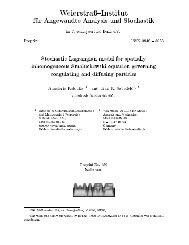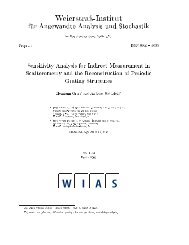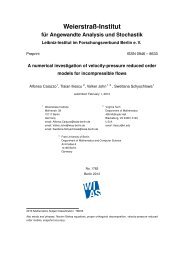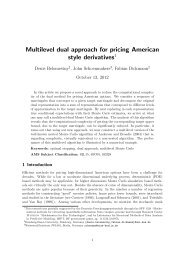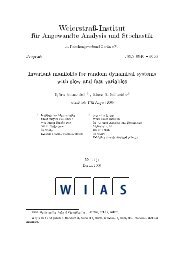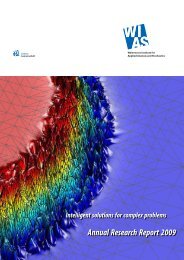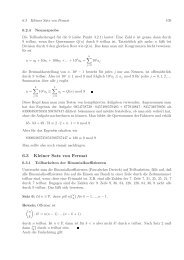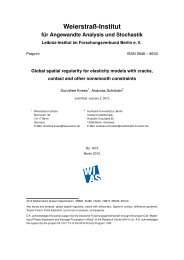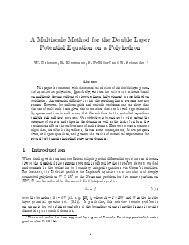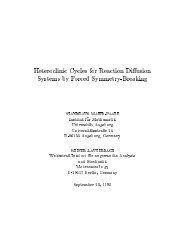PDF (5143 kByte) - WIAS
PDF (5143 kByte) - WIAS
PDF (5143 kByte) - WIAS
You also want an ePaper? Increase the reach of your titles
YUMPU automatically turns print PDFs into web optimized ePapers that Google loves.
weighted images:<br />
˜w (k)<br />
<br />
:= Kloc ||v1 − v2||/h v1v2 (k)<br />
<br />
<br />
Kst z<br />
bl<br />
(k)<br />
v1v2 /λ<br />
<br />
,<br />
with the Euclidean norm . in R3 and a statistical penalty<br />
z (k)<br />
v1v2 :=<br />
<br />
<br />
1<br />
ˆS (k−1)<br />
(k−1) (v1,0)<br />
nS0 · Ñ · K<br />
v1<br />
ngrad + nS0<br />
ˆσ ,<br />
ˆS (k−1) ngrad <br />
(v2,0)<br />
+<br />
ˆσ<br />
l=1<br />
s (k)<br />
g (l)<br />
1 g(l)<br />
2<br />
where g (l)<br />
1 , l = 1, · · · ngrad, are the ngrad elements in R 3 ⋊ S 2 with v(g (l)<br />
1 ) = v1. Furthermore<br />
we define s (k)<br />
g1g2 as in Section 2.2 and<br />
Ñ (k)<br />
v1 := <br />
Adaptive estimates for the mean ¯ S0 are obtained as<br />
ˆS (k)<br />
<br />
(v1,0) =<br />
v2<br />
v2<br />
˜w (k)<br />
v1v2 .<br />
˜w (k) ¯S(v2,0)/<br />
(k)<br />
Ñ v1v2<br />
v1 .<br />
2.4. Choice of parameter values. The algorithm has a number of parameters, which mostly<br />
have only minor influence on the resulting estimates ˆ S (k∗ )<br />
g<br />
2006, Tabelow et al., 2008].<br />
<br />
7<br />
and ˆ S (k∗ )<br />
(v,0) [Polzehl and Spokoiny,<br />
The main parameter of the procedure is the adaptation parameter λ which controls the amount<br />
of adaptation. If λ is chosen very large, the influence of the value of the statistical penalty on<br />
the weights is negligible. If it is chosen too small, the procedure easily adapts to noise, which is<br />
equivalent to a random clustering of observed values. Fortunately, λ can be chosen independent<br />
of the data by applying the propagation condition [Polzehl and Spokoiny, 2006] to a simulated<br />
unstructured situation, i.e., with only one homogeneous region for Rician distributed data. This<br />
condition ensures that the quality of the estimates in this situation may deteriorate only by a<br />
factor 1 + α (e.g. α = 0.1) in comparison to its, in this case optimal, non-adaptive counterpart.<br />
Then, this property also holds for situations with more than one homogeneity region [Polzehl<br />
and Spokoiny, 2006], where the structural assumption is fulfilled.<br />
The kernel functions K : R + → [0, 1] should have compact support and be monotone decreasing.<br />
The kernel Kst should for theoretical reasons exhibit a constant plateau. The exact<br />
form of the kernels is not important [see e.g. Section 6.2.3 in Scott, 1992]. Here, we choose<br />
them as<br />
Kloc(x) =<br />
1 − x 2 x < 1<br />
0 x ≥ 1<br />
⎧<br />
⎨ 1 x < 0.5<br />
and Kst(x) = 2 − 2x<br />
⎩<br />
0<br />
0.5 ≤ x < 1<br />
x ≥ 1<br />
For a given gradient directionb the sequence of bandwidths {h( b, k)}k, starting with h( b, 0) =<br />
1, is chosen such that in case of non-adaptive weights ¯w (k)<br />
<br />
g1g2 = Kloc ∆κ( b,k) (g1, g2) /h( <br />
b, k) ,<br />
it provides a variance reduction 2 2 /<br />
from step k − 1 to step k by a fac-<br />
tor 1.25.<br />
g2 ¯w(k)<br />
g1g2<br />
g2 ¯w(k)<br />
g1g2<br />
.




